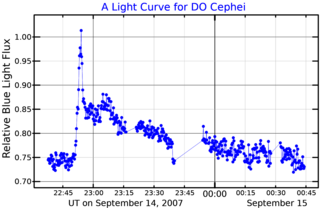
Krüger 60 is a binary star system located 13.1 light-years from the Sun. These red dwarf stars orbit each other every 44.6 years.

T Coronae Borealis, is a recurring nova in the constellation Corona Borealis. It was first discovered in outburst in 1866 by John Birmingham, although it had been observed earlier as a 10th magnitude star.
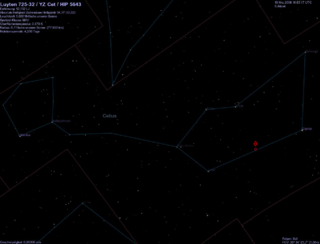
YZ Ceti is a red dwarf star in the constellation Cetus. Although it is relatively close to the Sun at just 12 light years, this star cannot be seen with the naked eye. It is classified as a flare star that undergoes intermittent fluctuations in luminosity. YZ Ceti is about 13 percent the mass of the Sun and 17% of its radius.

AD Leonis (Gliese 388) is a red dwarf star. It is located relatively near the Sun, at a distance of 16.2 light-years, in the constellation Leo. AD Leonis is a main sequence star with a spectral classification of M3.5V. It is a flare star that undergoes random increases in luminosity.

II Pegasi is a binary star system in the constellation of Pegasus with an apparent magnitude of 7.4 and a distance of 130 light-years. It is a very active RS Canum Venaticorum variable, a close binary system with active starspots.

LY Aurigae is a multiple star system in the constellation Auriga. It is an eclipsing binary variable star, dropping in brightness by 0.7 magnitudes every 4 days. The system is around a thousand light years away in the Auriga OB1 stellar association.

Gliese 268 is a RS Canum Venaticorum variable star in the Auriga constellation. RS CVn variables are binary star systems with a strong magnetic field influenced by each star's rotation, which is accelerated by the tidal effects of the other star in the system. Gliese 268 in particular is composed of a binary system of two M-type dwarfs, or red dwarfs, and is one of the one hundred closest star systems to the Earth. The primary component of the system has an apparent magnitude of 12.05, and the secondary component an apparent magnitude of 12.45. Neither is visible to the naked eye from Earth.

37 Comae Berenices is a variable star system located around 690 light years away from the Sun in the northern constellation of Coma Berenices. It has the variable star designation LU Comae Berenices. 37 Comae Berenices was a later Flamsteed designation of 13 Canum Venaticorum. This object is visible to the naked eye as a faint, yellow-hued star with a baseline apparent visual magnitude of 4.88. It is drifting closer to the Earth with a heliocentric radial velocity of −14 km/s.
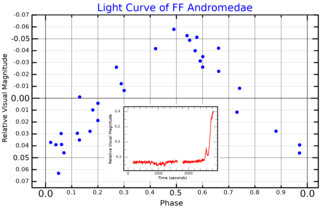
FF Andromedae is a spectroscopic binary in the constellation Andromeda. It has a typical apparent visual magnitude of 10.4, but undergoes flare events that can increase its brightness by about a magnitude.

RS Canum Venaticorum is a binary star system in the northern constellation of Canes Venatici. It serves as the prototype to the class of RS Canum Venaticorum variables. The peak apparent visual magnitude of this system is below the level needed to observe it with the naked eye. It is located at a distance of approximately 443 light years from the Sun based on parallax, but is drifting closer with a net radial velocity of −14 km/s. Olin J. Eggen (1991) included this system as a member of the IC 2391 supercluster, but it was later excluded.
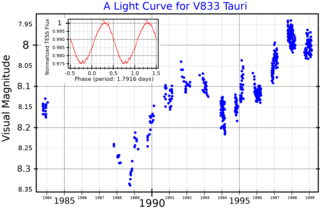
HD 283750, also known as V833 Tauri, is a K-type main-sequence star 57 light-years away from the Sun. The star is much younger than the Sun's at 1 billion years. HD 283750 is similar to the Sun in its concentration of heavy elements.

HD 165590 is a quintuple system dominated by the binary Algol variable star known as V772 Herculis. The system lies in the constellation of Hercules about 123 light years from the Sun, and is suspected to be a part of the Pleiades moving group.

XY Ursae Majoris is a short period binary star system in the northern circumpolar constellation of Ursa Major. It is an eclipsing binary with a baseline apparent visual magnitude of 9.50. The system is located at a distance of 221.5 light years from the Sun based on parallax measurements, but is drifting closer with a radial velocity of −10 km/s. It has a relatively high proper motion, traversing the celestial sphere at the angular rate of 0.191″·yr−1.

SZ Piscium is a suspected triple star system in the equatorial constellation of Pisces. The inner pair form a double-lined spectroscopic binary with an orbital period of 3.966 days. It is a detached Algol-type eclipsing binary of the RS Canum Venaticorum class with a subgiant component. The system is too faint to be readily visible to the naked eye with a combined apparent visual magnitude of 7.18. It is located at a distance of approximately 306 light years based on parallax measurements.

BH Virginis is a binary star system in the equatorial constellation of Virgo. With a typical apparent visual magnitude of 9.6, it is too faint to be visible to the naked eye. Based on parallax measurements, it is located at a distance of approximately 488 light years from the Sun. The system is drifting closer with a net radial velocity of −23 km/s.
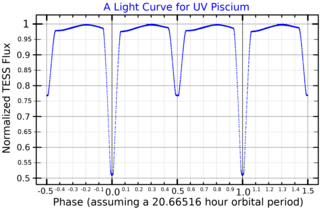
UV Piscium is a binary star system in the constellation of Pisces. With a peak apparent visual magnitude of 8.98, it is too faint to be visible to the naked eye. This is an eclipsing binary system that decreases to magnitude 10.05 during the primary eclipse, then to magnitude 9.54 with the secondary eclipse. It is located at a distance of 232 light years from the Sun based on parallax measurements, and is receding with a radial velocity of 6.5 km/s. The position of this star near the ecliptic means it is subject to lunar occultation.

ER Vulpeculae is a binary star system in the northern constellation of Vulpecula, abbreviated ER Vul. It is a variable star system with a brightness that ranges from an apparent visual magnitude of 7.27 down to 7.49, which is too faint to be visible to the naked eye. This system is located at a distance of 165 light years from the Sun based on parallax measurements. It is drifting closer with a radial velocity of −25 km/s.

DM Ursae Majoris is a binary star system in the northern circumpolar constellation of Ursa Major, abbreviated DM UMa. It is sometimes identified by the Bonner Durchmusterung catalogue designation BD +61 1211; DM UMa is the variable star designation. The system has a combined apparent visual magnitude of 9.29, which is too faint to be visible to the naked eye. Based on parallax measurements, the system is located at a distance of approximately 606 light years from the Sun, but it is drifting closer with a heliocentric radial velocity of −7 km/s.

HR 1099 is a triple star system in the equatorial constellation of Taurus, positioned 11′ to the north of the star 10 Tauri. This system has the variable star designation V711 Tauri, while HR 1099 is the star's identifier from the Bright Star Catalogue. It ranges in brightness from a combined apparent visual magnitude of 5.71 down to 5.94, which is bright enough to be dimly visible to the naked eye. The distance to this system is 96.6 light years based on parallax measurements, but it is drifting closer with a radial velocity of about −15 km/s.

DV Piscium is a triple star system in the equatorial constellation of Pisces, abbreviated DV Psc. It is an eclipsing binary variable of the RS Canum Venaticorum class. The pair have a combined apparent visual magnitude of 10.59, which is too faint to be visible with the naked eye. Based on parallax measurements, DV Piscium is located at a distance of 137.5 light years from the Sun. It is drifting closer with a radial velocity of −28 km/s.




















